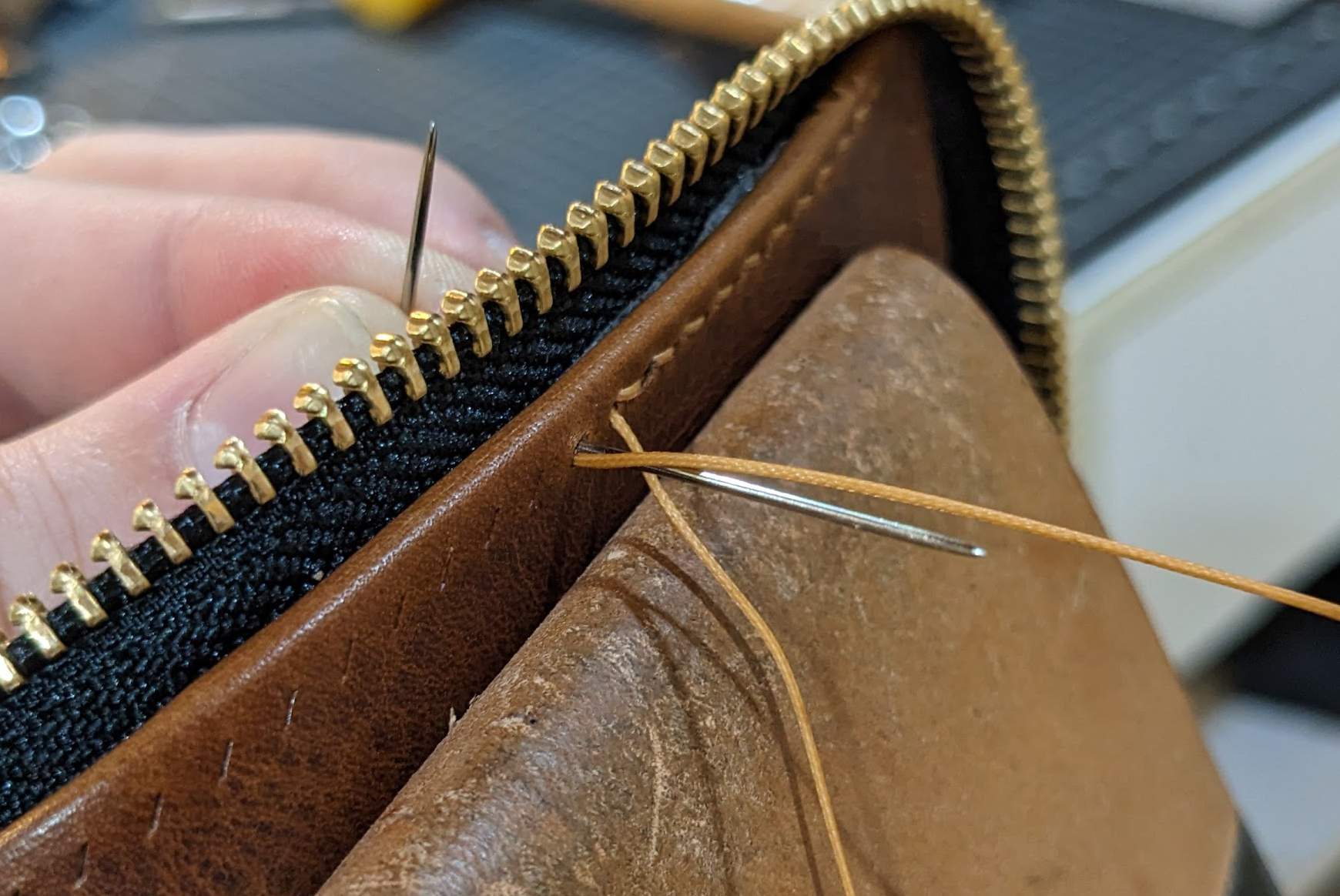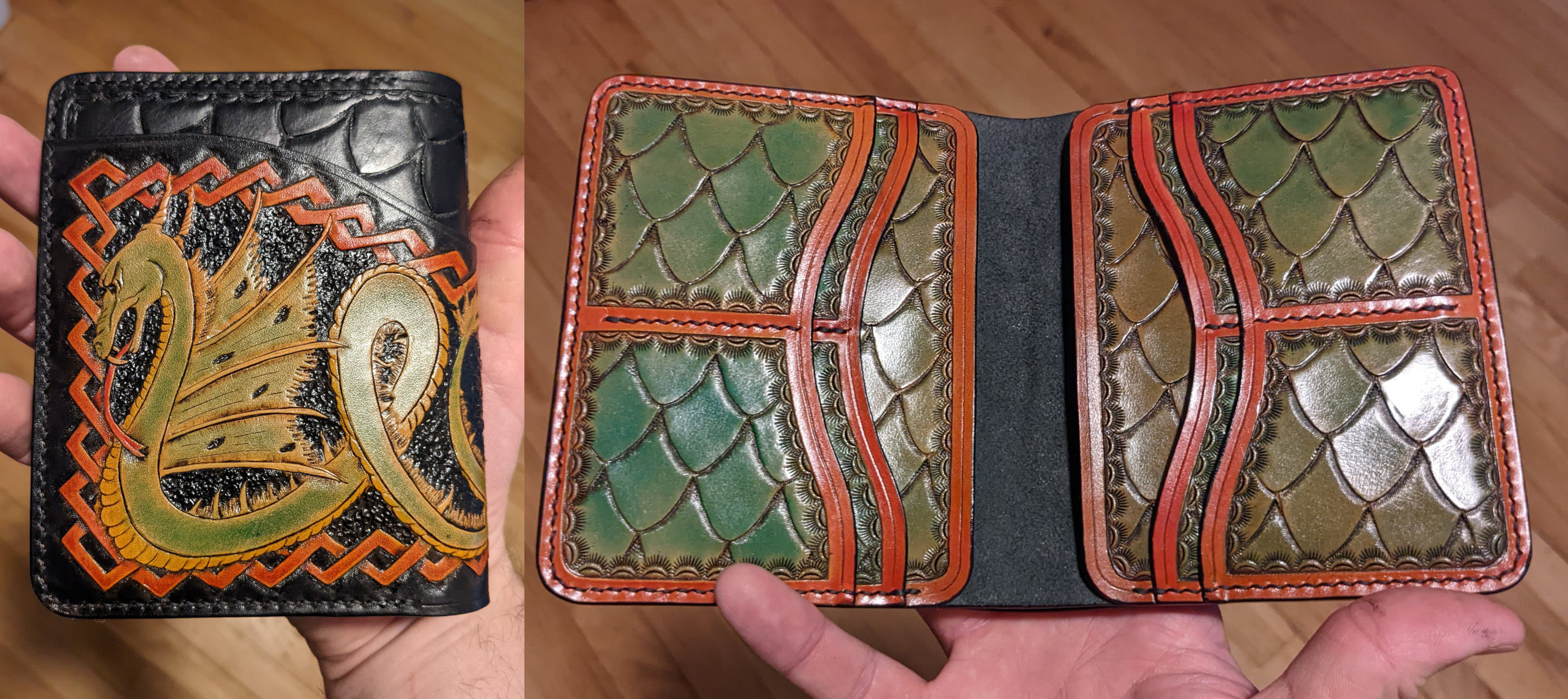What's the Deal with Stitching?
Colin's Workshop · 4 minute read

Hand stitched items are unmatched in quality and durability
Have you ever noticed a stray thread on your shirt? Personally, I can never resist the urge to give it a yank. And inevitably, when I do, it runs, causing a row of stitches come loose and before I know it the seam is weakened or falling apart altogether.
Stitching is something most of us these days take for granted. Machines do it for us quickly and cheaply, and that's that. This mentality is fine for an item which is not intended nor expected to last, but for truly durable goods, it's far from ideal.
The alternative to machine stitching is hand stitching, and in leatherwork this usually means the traditional saddle stitch. But saddle stitching, and hand stitching in all its forms, takes ages and requires a lot of practice, not to mention patience. Is it really worth the investment?
Honestly? It depends on what you want. If you want something done cheaply, something that you don't care a whole lot about and intend to throw away once it's reached the end of its shelf life, then no, hand stitching is certainly not worth it. But if you want your goods to last -- to be elevated from "items" to "heirlooms" -- then hand stitching is the way to go. If you want to own the best possible quality, hand-stitched is really the only acceptable answer.
There are several elements that contribute to making hand stitching far superior to machine stitching. The type of thread matters. How the thread is prepared matters. Perhaps most importantly, the technique itself matters.
Stitching is something most of us these days take for granted. Machines do it for us quickly and cheaply, and that's that. This mentality is fine for an item which is not intended nor expected to last, but for truly durable goods, it's far from ideal.
The alternative to machine stitching is hand stitching, and in leatherwork this usually means the traditional saddle stitch. But saddle stitching, and hand stitching in all its forms, takes ages and requires a lot of practice, not to mention patience. Is it really worth the investment?
Honestly? It depends on what you want. If you want something done cheaply, something that you don't care a whole lot about and intend to throw away once it's reached the end of its shelf life, then no, hand stitching is certainly not worth it. But if you want your goods to last -- to be elevated from "items" to "heirlooms" -- then hand stitching is the way to go. If you want to own the best possible quality, hand-stitched is really the only acceptable answer.
There are several elements that contribute to making hand stitching far superior to machine stitching. The type of thread matters. How the thread is prepared matters. Perhaps most importantly, the technique itself matters.
Comparing Techniques
To really understand what makes the hand stitch so much better, it's helpful to understand how it's different. A sewing machine, even one made for leatherwork, is fundamentally incapable of producing a true traditional saddle stitch. Instead it must be approximated, and this is where the tradeoffs creep in. The devil's in the details.
A sewing machine produces a stitch called a lockstitch. This style of stitch passes a thread into the hole, wraps it around a second thread, and then backs it out of the hole the way it came in. This creates a sort of continuous intertwining that holds the material together. The problem with this style of stitch is the infamous running thread: when either thread breaks anywhere along the seam, the twist loses tension, and the entire seam rapidly falls apart.

With hand stitching, two threads are used as with a machine, but that's where the similarities end. A hand stitched thread follows a completely different path. Instead of twisting around and backing out, both threads pass completely through each hole to emerge on the other side of the material. This creates a zig-zag pattern within the material, crossing from one side to the other and then back on every other stitch.

More Than Meets the Eye
Because the threads are independent, one thread can break and the other provides a level of redundancy, holding the seam together. The tension on the good thread also helps maintain tension on a broken one, so a broken thread won't run, either. Even if both threads are broken, the seam can usually hold strong for a long time.
On top of this, the threads used at D20 Creations have been impregnated with beeswax. Since beeswax is sticky when cool, it helps lock the threads into place, bonding the two threads together within each stitch. If a stitch should break, beeswax contributes to maintaining the tension along the still-good lengths of the broken thread.
What's more, the wax helps seal and protect the thread from abrasions and the elements, so that the thread lasts longer and is less likely to break in the first place.
Although purpose-built machines can use waxed thread, they often don't, because it gums up the machines and requires frequent cleaning.
As for the thread itself, woven polyester is the material of choice. Polyester is rot-proof, and using multiple braided strands creates a very strong thread that can take a surprising amount of stress. Some leather workers prefer to use linen thread, which is a very traditional option, but it tends to break down over time and is not as strong as polyester, so those items will need to be repaired at some point. Since the longevity of my items is paramount, I tend to lean towards polyester.
On top of this, the threads used at D20 Creations have been impregnated with beeswax. Since beeswax is sticky when cool, it helps lock the threads into place, bonding the two threads together within each stitch. If a stitch should break, beeswax contributes to maintaining the tension along the still-good lengths of the broken thread.
What's more, the wax helps seal and protect the thread from abrasions and the elements, so that the thread lasts longer and is less likely to break in the first place.
Although purpose-built machines can use waxed thread, they often don't, because it gums up the machines and requires frequent cleaning.
As for the thread itself, woven polyester is the material of choice. Polyester is rot-proof, and using multiple braided strands creates a very strong thread that can take a surprising amount of stress. Some leather workers prefer to use linen thread, which is a very traditional option, but it tends to break down over time and is not as strong as polyester, so those items will need to be repaired at some point. Since the longevity of my items is paramount, I tend to lean towards polyester.
Spotting the Difference
When you're looking at a machine-sewn item, there are usually tell-tale signs. Machines almost always mark the leather, sometimes faintly, sometimes boldly. As the foot steps along the seam, it puts pressure on the leather and mars it slightly. The foot pressure can be reduced to minimize the marks, but some pressure is needed and they can't be removed completely. The leatherworker can attempt to rub them out, with varying degrees of success. So if you can see lines and indentations running along the seam, it was machined.

The stitch itself usually looks different, too. There will often be less tension in order to minimize the marks shown above, so the thread tends to rest on the surface of the leather, rather than being pulled tightly into the leather. (This introduces another quality tradeoff: a thread that is not pulled tight sits too high above the surface of the material, making it prone to abrasion as it rubs against other surfaces, and will break sooner. This is also true of hand stitching, which is why an experienced leatherworker is important. The craftsman must use enough tension to protect the thread, but not so much as to stress the leather.)
A traditional European saddle stitch is easy to spot, because of its distinctive angled threads. Not everyone uses this, though. It's a purely aesthetic choice and some craftsmen like the look while others do not. However, a machine can't match it. A well-made and properly-configured machine can come close, but it won't ever quite look the same.

The D20 Difference
You won't find machine stitched items here. D20 Creations stands for quality, durability, and beauty. Sewing machines do have their place, but as with so many things, they are a matter of tradeoffs. In general, they trade quality for cost and beauty for speed. And this is a sacrifice D20 Creations is simply unwilling to make.
If you'd like to see what it's like to hand stitch, check out the video below.


